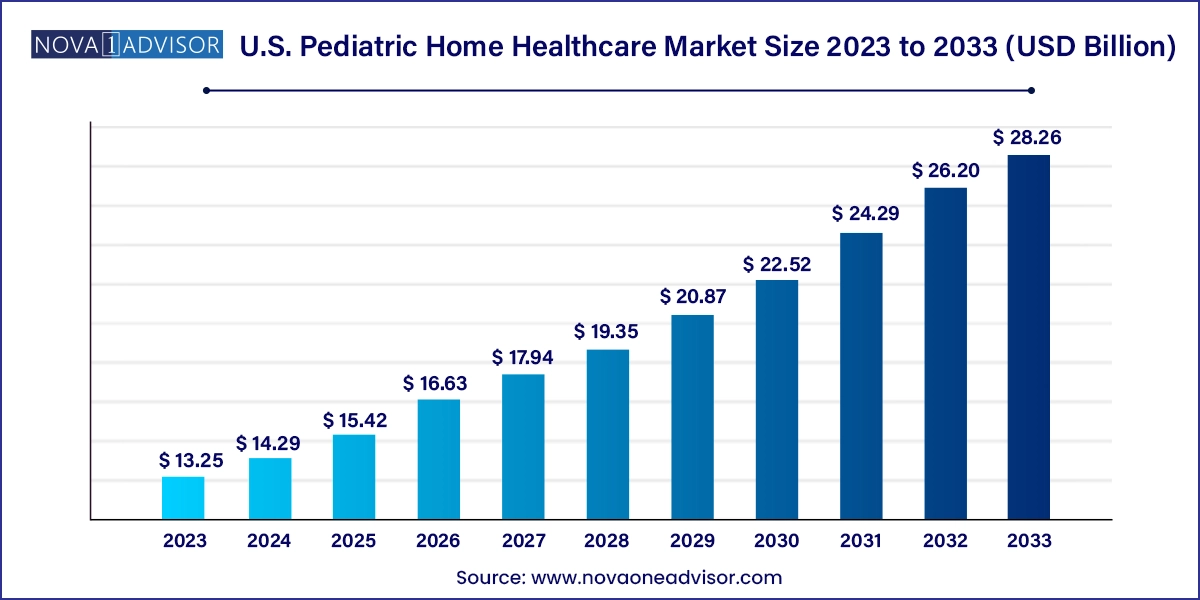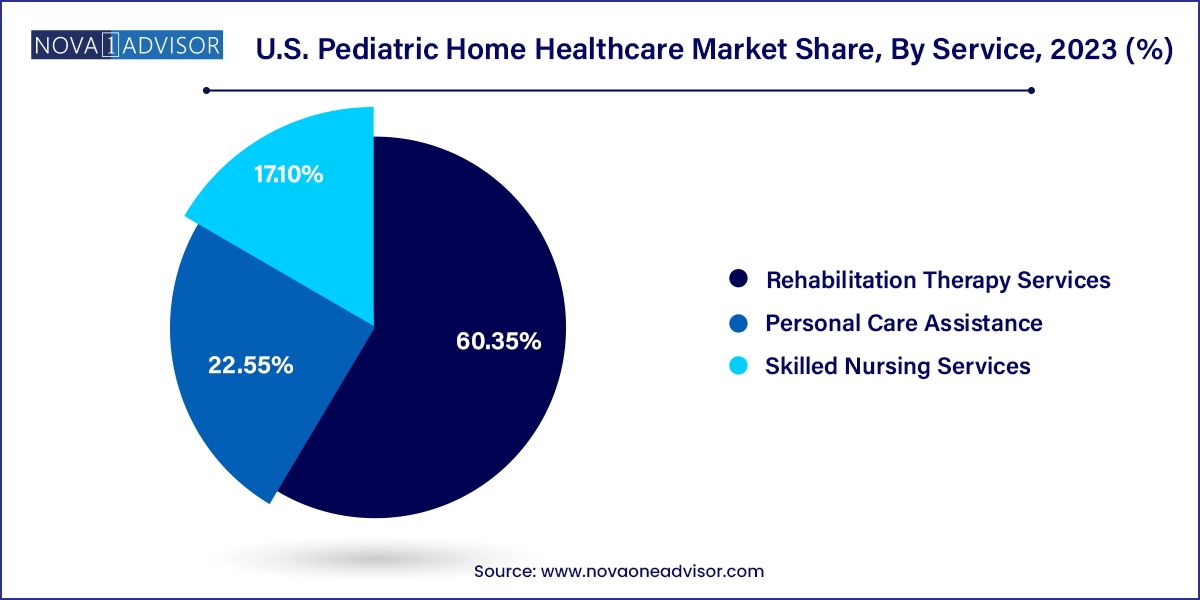The U.S. pediatric home healthcare market size was exhibited at USD 13.25 billion in 2023 and is projected to hit around USD 28.26 billion by 2033, growing at a CAGR of 7.82% during the forecast period 2024 to 2033.

The U.S. pediatric home healthcare market addresses the specialized medical and non-medical needs of children with chronic illnesses, disabilities, or those recovering from medical procedures within the comfort of their homes. This approach not only enhances the quality of life for pediatric patients but also offers a cost-effective alternative to prolonged hospital stays.
Over recent years, there has been a noticeable shift towards home-based care, driven by advancements in medical technology, a growing emphasis on patient-centered care, and the rising prevalence of chronic conditions among children. Families and healthcare providers are increasingly recognizing the benefits of home healthcare, including personalized attention, reduced risk of hospital-acquired infections, and the psychological comfort of being in a familiar environment.
The integration of telehealth services has further revolutionized pediatric home healthcare, enabling real-time monitoring and consultations, thus bridging the gap between hospital care and home settings. This evolution reflects a broader trend in the U.S. healthcare system towards decentralization and the prioritization of holistic, patient-centric models of care.
Technological Advancements in Home Care Equipment: The development of portable and user-friendly medical devices has facilitated complex care procedures at home, enhancing patient comfort and compliance.
Integration of Telehealth Services: Telemedicine platforms are being increasingly adopted, allowing for remote consultations, monitoring, and timely medical interventions without the need for frequent hospital visits.
Emphasis on Family-Centered Care Models: Healthcare providers are focusing on involving families in the care process, offering training and support to ensure effective home-based care.
Expansion of Insurance Coverage: There is a growing trend of insurance providers extending coverage to include pediatric home healthcare services, making them more accessible to a broader population.
Rise in Specialized Pediatric Home Care Programs: Tailored programs addressing specific conditions like cystic fibrosis, cerebral palsy, and congenital heart defects are being developed to provide specialized care at home.
Workforce Development Initiatives: Efforts are underway to train and certify more healthcare professionals in pediatric home care, addressing the demand for skilled providers in this niche sector.
Collaborations Between Healthcare Providers and Tech Companies: Partnerships are forming to develop innovative solutions that enhance the efficiency and effectiveness of home healthcare services.
Regulatory Support and Policy Initiatives: Government policies are increasingly supporting home healthcare models, recognizing their potential to reduce healthcare costs and improve patient outcomes.
| Report Coverage | Details |
| Market Size in 2024 | USD 14.29 Billion |
| Market Size by 2033 | USD 28.26 Billion |
| Growth Rate From 2024 to 2033 | CAGR of 7.82% |
| Base Year | 2023 |
| Forecast Period | 2024-2033 |
| Segments Covered | Service, Region |
| Market Analysis (Terms Used) | Value (US$ Million/Billion) or (Volume/Units) |
| Regional Scope | U.S. |
| Key Companies Profiled | Aveanna Healthcare, LLC; Care Options for Kids; Pediatric Home Service; Pediatric Home Healthcare; At Home Healthcare; Entrusted Pediatric Home Care; Children’s Home Care; Interim HealthCare Inc; Continuum Pediatric Nursing |
Rehabilitation Therapy Services dominate the service segment, accounting for a significant portion of the market. These services encompass physical, occupational, and speech therapies aimed at enhancing the functional abilities of children recovering from injuries, surgeries, or managing developmental disorders. The emphasis on early intervention and personalized therapy plans has led to increased demand for home-based rehabilitation, allowing children to receive consistent care in a comfortable environment. For instance, children with cerebral palsy often require ongoing physical therapy to improve mobility and prevent musculoskeletal complications, which can be effectively administered at home.

Personal Care Assistance is the fastest-growing segment, driven by the increasing need for support with daily activities for children with chronic illnesses or disabilities. Services include assistance with bathing, dressing, feeding, and mobility, aiming to enhance the child's quality of life and provide respite for family caregivers. The growing recognition of the importance of holistic care, addressing both medical and non-medical needs, has propelled the demand for personal care assistance. For example, children with muscular dystrophy may require help with mobility and personal hygiene, services that can be effectively provided through home-based personal care assistance.
This report forecasts revenue growth at country levels and provides an analysis of the latest industry trends in each of the sub-segments from 2021 to 2033. For this study, Nova one advisor, Inc. has segmented the U.S. pediatric home healthcare market
Service
Regional